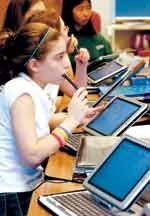Kids and Tablets
 My daughter has recently inherited by old Tablet PC, a TC1000. She has an auto-immune disorder and secondary Raynaud’s and these conditions mean that she suffers from cold hands, is very stiff and not that strong. As a result she often struggles to carry her bag around and with writing. About a year ago I wrote an article explaining why I thought a Tablet would help here and a few weeks ago I demonstrated my Tablet to the school teachers and her assessors. As a result they have agreed that they will try and get her a grant for a Tablet ready for high school which is great news. In addition they will get her a book scanner. Although scanned books are not perfect, nor many eBooks, as I mention here, they are often better than paper.
My daughter has recently inherited by old Tablet PC, a TC1000. She has an auto-immune disorder and secondary Raynaud’s and these conditions mean that she suffers from cold hands, is very stiff and not that strong. As a result she often struggles to carry her bag around and with writing. About a year ago I wrote an article explaining why I thought a Tablet would help here and a few weeks ago I demonstrated my Tablet to the school teachers and her assessors. As a result they have agreed that they will try and get her a grant for a Tablet ready for high school which is great news. In addition they will get her a book scanner. Although scanned books are not perfect, nor many eBooks, as I mention here, they are often better than paper.
In preparation she is taking her Tablet into school 3 days a week to get used to the logistics and the envious kids and how to deal with them. Since she got the Tablet I noticed that she has started using the computer at home a lot more as well. I often find her sitting in bed browsing the web, writing …



 I have thought for a long time that
I have thought for a long time that 
 I only work part-time and have been struggling to find a way to manage my time, it’s been a long process and has so fair failed to control overload.
I only work part-time and have been struggling to find a way to manage my time, it’s been a long process and has so fair failed to control overload.
 Here is a
Here is a 
 Listen
Listen 
 Listen
Listen 
 Listen
Listen 
 Listen
Listen 